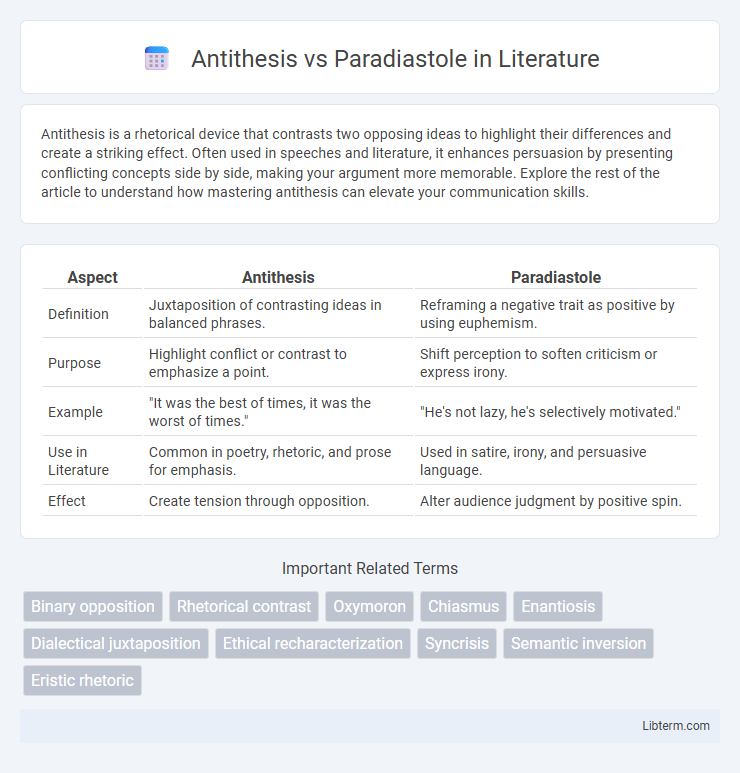Antithesis is a rhetorical device that contrasts two opposing ideas to highlight their differences and create a striking effect. Often used in speeches and literature, it enhances persuasion by presenting conflicting concepts side by side, making your argument more memorable. Explore the rest of the article to understand how mastering antithesis can elevate your communication skills.
Table of Comparison
| Aspect | Antithesis | Paradiastole |
|---|---|---|
| Definition | Juxtaposition of contrasting ideas in balanced phrases. | Reframing a negative trait as positive by using euphemism. |
| Purpose | Highlight conflict or contrast to emphasize a point. | Shift perception to soften criticism or express irony. |
| Example | "It was the best of times, it was the worst of times." | "He's not lazy, he's selectively motivated." |
| Use in Literature | Common in poetry, rhetoric, and prose for emphasis. | Used in satire, irony, and persuasive language. |
| Effect | Create tension through opposition. | Alter audience judgment by positive spin. |
Understanding Antithesis: Definition and Purpose
Antithesis is a rhetorical device that contrasts two opposing ideas within a sentence or phrase to highlight their differences and create emphasis. Its primary purpose is to enhance clarity and persuasiveness by juxtaposing conflicting concepts, often using parallel structure to make the contrast more striking. This technique is commonly employed in literature, speeches, and persuasive writing to provoke thought and underscore key messages.
What Is Paradiastole? Exploring Its Meaning
Paradiastole is a rhetorical device that redefines a potentially negative trait by framing it in a positive light, often using euphemism or recharacterization. Unlike antithesis, which contrasts opposing ideas to emphasize difference, paradiastole moderates judgment by altering perception through language. This technique is commonly employed in persuasive speech and literature to soften criticism and influence audience interpretation effectively.
Historical Contexts of Antithesis and Paradiastole
Antithesis, rooted in classical rhetoric dating back to Aristotle and Cicero, was extensively used in ancient Greek and Roman speeches to create contrast and emphasize opposing ideas. Paradiastole emerged later in rhetorical traditions, primarily in biblical and medieval literature, serving to reframe negative concepts in a positive light through euphemistic comparison. Understanding these historical contexts highlights antithesis as a tool for conflict and clarity, while paradiastole functions to soften judgments and influence moral perceptions.
Structural Differences: How Antithesis and Paradiastole Work
Antithesis structurally contrasts two opposing ideas in parallel grammatical constructions to highlight their difference, creating a clear dichotomy. Paradiastole, by contrast, redefines or positively reframes a negative trait using euphemistic language, altering the perception without direct opposition. Both employ juxtaposition, but antithesis emphasizes contrast, while paradiastole shifts interpretation within the same structural framework.
Rhetorical Impact: Persuasion Through Contrast
Antithesis and paradiastole both utilize contrast to enhance rhetorical impact, but while antithesis juxtaposes opposing ideas to highlight clear distinctions and create dramatic emphasis, paradiastole reframes negative traits into positive or neutral terms, subtly altering perception and persuasion. Antithesis strengthens arguments by creating tension and clarity through opposition, making the message more memorable and forceful. Paradiastole's power lies in its ability to soften or rehabilitate negative concepts, persuading audiences by shaping attitudes rather than starkly opposing ideas.
Common Examples of Antithesis in Literature
Common examples of antithesis in literature include Charles Dickens' "It was the best of times, it was the worst of times" from *A Tale of Two Cities*, which contrasts opposing ideas to highlight conflict; Shakespeare's "To be, or not to be" in *Hamlet*, presenting life and death as opposing states; and John F. Kennedy's inaugural address phrase "Ask not what your country can do for you--ask what you can do for your country," using parallel structure to emphasize contrasting duties. Antithesis structurally juxtaposes contrasting ideas within parallel syntax, while paradiastole redefines moral qualities through euphemistic reframing rather than opposition. This rhetorical distinction clarifies how writers manipulate meaning either by direct opposition or by reinterpreting attributes with stylistic nuance.
Paradiastole in Action: Illustrative Examples
Paradiastole reframes a potentially negative trait into a positive or neutral light, as seen when describing stubbornness as determination or persistence. Unlike antithesis, which contrasts opposing ideas for emphasis, paradiastole reinterprets a characteristic to alter perception without direct opposition. An example includes calling someone "selectively attentive" instead of inattentive, highlighting paradiastole's power in rhetorical persuasion and characterization.
When to Use Antithesis vs Paradiastole
Use antithesis to emphasize stark contrasts between opposing ideas, enhancing clarity and impact in persuasive writing or speeches. Employ paradiastole when reframing negative traits or situations in a more positive or neutral light, often to soften criticism or highlight alternative interpretations. Choosing between antithesis and paradiastole depends on whether the goal is to highlight opposition or to offer a nuanced redefinition.
Misconceptions and Overlaps Between Both Terms
Antithesis and paradiastole are often confused due to their reliance on contrasting ideas, but antithesis juxtaposes opposing concepts directly for rhetorical effect, while paradiastole reframes negative traits as positive or neutral through euphemistic contrast. A common misconception is that both serve the same purpose in rhetoric; however, antithesis emphasizes stark opposition whereas paradiastole aims to soften judgment by redefining terms. Overlaps occur when both techniques use contrast, but their intent and linguistic execution differ, with antithesis appealing to logical balance and paradiastole focusing on moral or emotional reevaluation.
Enhancing Your Writing: Choosing the Right Device
Antithesis emphasizes contrasting ideas within a sentence to highlight differences and create a balanced structure, enhancing clarity and impact in writing. Paradiastole reframes potentially negative traits as positive by using euphemistic language, which can soften tone and influence reader perception. Selecting antithesis strengthens argumentative precision, while paradiastole is effective for persuasive or nuanced character descriptions.
Antithesis Infographic

 libterm.com
libterm.com